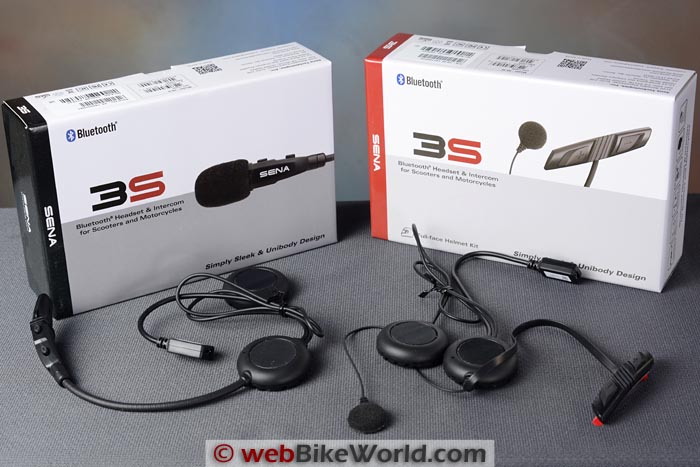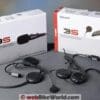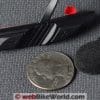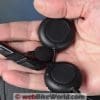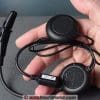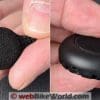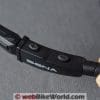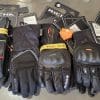Simple is good (or better) and the new Sena 3S is that for sure.
Remember “Murder, My Sweet”? Moose Malloy would say that the 3S is “cute as lace pants”.
The Moose is right, of course. But he’s always right. Who’s going to argue with him?
The cuteness factor is a result of two words: “tiny” and “light”. A couple of shillings weigh more.
Intercoms just work nowadays without much differentiation, so maybe the best thing about the 3S is how easy it is to use. Only 2 buttons control the works.
There are two versions available: the 3S-B with a boom mic or the 3S-W with a — you guessed it — Lilliputian microphone. There’s an issue related to that and we’ll get into it in this review.
There is no intercom module per se with the 3S. The batteries are contained in the speakers and the on/off and control buttons — all 2 of them — are on a sliver of a stick-on (3S-w) or built into the mic on the boom version.
The 3S may not have all the bells-und-whistles but…who needs ’em?
You want to talk; listen to music and some crazy people even want to take a phone call while they’re riding. Check, check and check.
And Bluetooth 3.0 means faster data rates and lower power consumption — both very good things.
OK, here’s the best part: the Sena 3S has a list price of just 99 bucks and can be had for around $89.00 (here). Intercom heaven? Maybe…
Background
The Sena 3S was announced during the webBikeWorld live coverage of the 2014 AIMExpo show (report) in Orlando, Florida.
But wait — haven’t we seen something like this before? Sharp-eyed webBikeWorld readers will remember the forerunner of the 3S, covered in the Nexx SXCOM intercom review.
The SXCOM was the first iteration of a self-contained motorcycle intercom system and the progenitor of the 3S.
The SXCOM is a joint project of Sena and Nexx and Nexx offered it as part of its category-busting Nexx SWITX SX.10 helmet (review), last year’s webBikeWorld Motorcycle Product of the Year Award winner.
The 3S is smaller, lighter and updated. Is this the future of motorcycle intercoms? Noting the miniaturization trend line, this could be.
And why not? A pair of speakers and a mic, with nano-sized electronics is all you need. Now all we have to do is get rid of the wires…
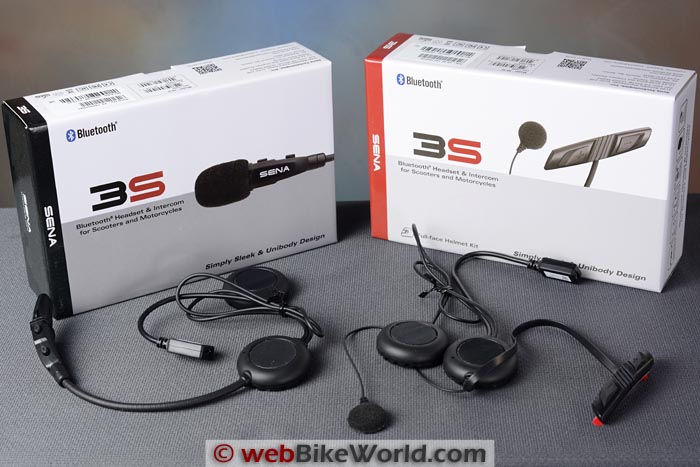
The Sena 3S
OK, let’s get into some of the 3S specifics. The Sena 3S was announced in this webBikeWorld report during the 2014 AIMExpo in the Fall of 2014.
Cribbing some of the info from that report, the 3S is a “self-contained” intercom that includes a Bluetooth 3.0 stereo headset and Bluetooth intercom.
It’s the next generation of the system Sena designed for Nexx: the Nexx SX-Com (review) that we reviewed a couple of years ago.
As I wrote in the 3S preview, “While the 3S may not have all the features of higher-end intercom communications systems like the Sena SMH10B (review), the Sena 20S (review) or others, it has ‘everything you need and nothing you don’t’.”
I also wrote “Sometimes, simpler is better”, and that holds true for sure. I’m a big fan of simple, especially when I’m on a motorcycle.
But make no mistake: the Sena 3S has a full complement of features, even including a built-in voice prompt/spoken status announcement system.
The 3S has features we could only dream of just a few years ago.
Long-time webBikeWorld readers will recall some of the problems we had with the very first motorcycle Bluetooth intercoms we reviewed 10 years ago. Think about that!
Those systems were very difficult to use — you had to tape a “cheat sheet” to the gas tank to remember the button-pushing sequence needed to get the things to work. And they worked intermittently, if at all…
Range was measured in centimeters and owners considered themselves lucky to be able to talk to their passenger…if each person could figure out the correct button push to connect.
Anyway, the point is that the 3S is light years beyond that and it’s as good as the best motorcycle intercom systems available only a few years ago.
What don’t you get? It pairs with one other Sena intercom only, because it does not have the “Universal Intercom” function that will allow it to pair with other brands, like the higher-end Sena products.
Nor does it have multi-pairing capability, so you can’t pair it with multiple systems in a “chain”.
Distance is rated at 200 meters, compared to 700 to 2km for other Sena systems. The 3S doesn’t have intercom VOX, nor does it have an FM radio, music sharing and a few other features.
The complete Sena communication systems comparison chart can be found here. Does any/all of this matter? For most motorcycle intercom evolutions, probably not.
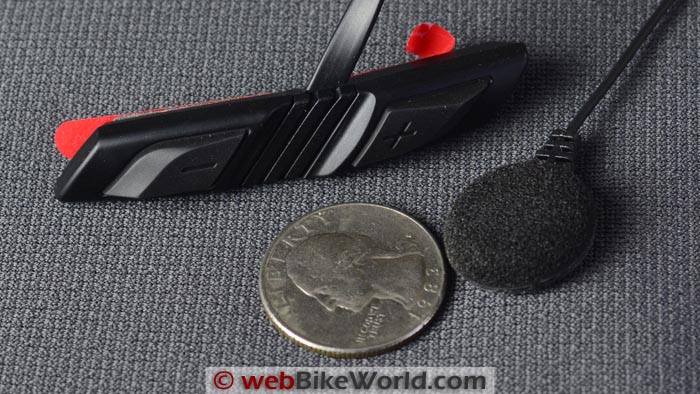
Sena 3S Features
- Two-buttons on the control pad on the mic or the external mount control all features.
- Bluetooth intercom up to 200 meters (220 yards) in open terrain.
- Bluetooth pairing for mobile phones (can connect dual mobile phones).
- Voice prompts.
- Bluetooth stereo headset with A2DP.
- Bluetooth music playback control by AVRCP: play, pause, track forward and track back.
- Integrated audio booster.
- Up to 8 hours talk time, 7 days stand-by time.
- Individual volume control for each audio source.
- Firmware upgradeable.
- Two-year warranty.
Sena 3S Specifications
- Talk time: 8 hours.
- Stand-by time: 7 days.
- Working distance (intercom): up to 200 meters (220 yards) in open terrain.
- Operating temperature: -10˚C ~ 55˚C (14°F ~ 131°F).
- Dimensions:
- Speaker: 39.9 mm x 39.9 mm x 11.3 mm ( 1.6 in x 1.6 in x 0.4 in )
- Boom microphone length: 180.0 mm ( 7.1 in )
- Weight:
- Headset: 59 g ( 2.08 oz. )
- Bluetooth:
- Profile: Headset Profile, Hands-Free Profile (HFP), Advanced Audio Distribution Profile (A2DP), Audio Video. Remote Control Profile (AVRCP).
- Bluetooth 3.0
- Audio:
- Built-in SBC Codec
- Noise cancellation
- Wind noise reduction
- Wide volume control
- Sample rate: 48kHz (DAC)
- Battery:
- Charging time: 2.5 hours
- Type: Lithium polymer battery
In the Box
- Bluetooth Built-in Speaker-microphone Unit
- USB Power & Data Cable (Micro USB Type)
- Microphone Sponges
- Male Velcro Pads for Speakers
- Female Velcro Pads for Speakers
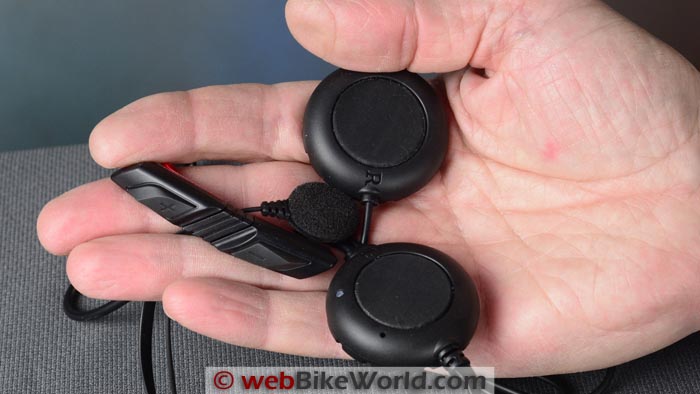
Using the Sena 3S
The “simpler is better” approach is apparent both in the physical attributes of the 3S and when operating the device.
There’s a micro 4-page “Quick Start” leaflet in the box, slathered in easy-to-understand graphics, and it’s really all you need to get to comm-ming. (All of the Quick Start guides and owners’ manuals can be downloaded in .pdf form from Sena).
First, of course, you’ll have to give it a charge. There’s USB pigtail attached to the left speaker; connect it to a power source and fill ‘er up. It took just about the predicted 2.5 hours to fully charge a 3S from empty.
A plug-in USB wall charger is available as an option, but a standard mini-USB cell phone charger will work.
Even better, let Ol’ Sol do the work by using the Solar JOOS solar charger and battery (review). It’s built like a tank and I’ve been using mine for a couple of years now to charge intercoms and other devices for “free”.
Once your 3S is packed with photonically generated electrons, all it takes to power it up is a two-fingered press on the + and – buttons.
Everything in the system is controlled with these two; a refreshing change from the multi-button approach.
My theory is that each additional intercom button brings and order of magnitude of complexity to operating the thing, and my Neanderthal brain can’t handle it.
Those plus and minus buttons work the volume (naturally) and also the intercom, phone, MP3 or GPS pairing (5-second press on the + button).
A 5-second press on the minus button sets up the pairing with another Sena communications system.
My Android HTC One died a sudden death, so I’ve been using a $29.00 Nokia 520 Windows phone lately that I’ve come to appreciate.
It’s simpler and the system works without any of the constant and puzzling Android quirks I experienced.
This is especially the case with Bluetooth connections.
The Windows phone knows all and simply connects when something comes into range, with no user intervention (as long as the Bluetooth function is running in the background).
Burn and I ran with the 3S systems paired and paired with a Sena SMH10B (review) and everything worked with no issues.
Once again, this is a huge difference from back in the dark ages of motorcycle Bluetooth intercoms, when pretty much nothing worked as planned.
There’s a little bit of confusion in the Quick Start guide, however. Page 3 has the graphical guide to “Headset Pairing” and it shows holding the minus button for 5 seconds to put the 3S in pairing mode.
Place the second 3S in pairing mode by doing the same and once you hear the “headset pairing” voice, you have to press the minus button again on either headset to pair.
The Quick Start guide shows an arrow with “Status LED”, which to me reads “press the minus key after the phones are paired to see the status”.
In fact, there should be a better indication to “press the minus key to complete the pairing” instead.
A minor issue but one that might trip up first-timers. It stumped Burn and me until wedownloaded and read the full instruction set .pdf, which describes the procedure in detail on Page 16.
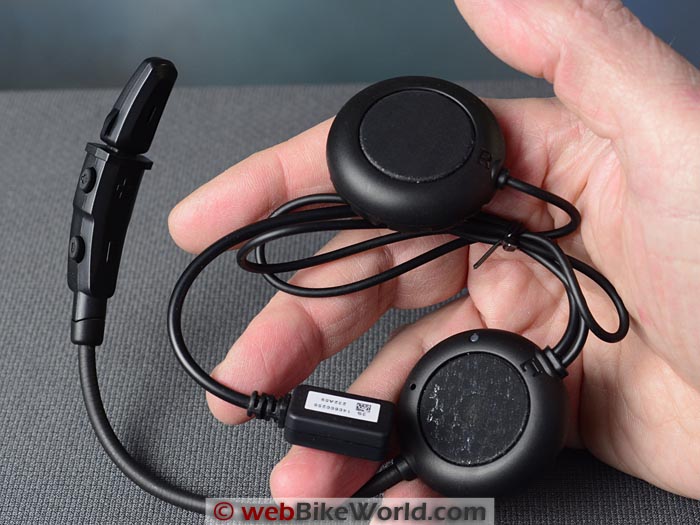
Sound Quality
OK, so you’re giving up a little bit on max volume with the 3S; after all, those speakers contain the brains and the engine for the thing.
The speakers are a bit on the porky side too, at about 11 mm thick (and 40 mm in diameter).
You’ll need a good ear pocket arrangement to make it work…although that could be said for nearly every motorcycle intercom system.
We agreed that the sound could be described as “good” and it’s actually fairly loud if you want it to be, even over the bike and engine noises.
These aren’t Iasus XSound 3 speakers (review) or Interphone Pro Sound speakers (review), but once more, they’re better than any speaker available just a few short years ago.
The 3S microphones are actually pretty sensitive, so you probably won’t need to get the mic pressed as close to your mouth as other intercom systems. If the mic is too close and the volume is set too high and you may overwhelm the speakers.
Music sound quality is also good; the 3S system is stereo and you can discern some bass response and the mid-high and high tones are a bit muddled.
But for the price, it’s not really an issue and for most intercom conversations, it’s fine.
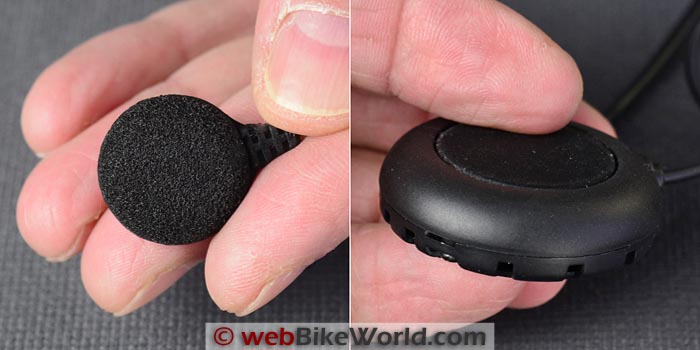
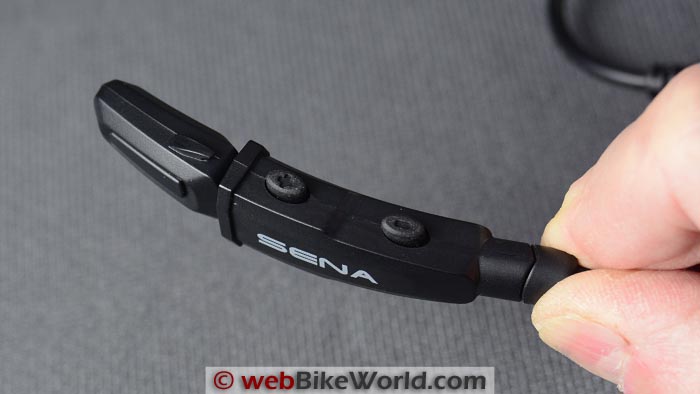
Boom or Wired?
The 3S is so simple, there isn’t really all that much to discuss. But there’s one issue to note: there’s a compromise here that potential owners need to understand.
The 3S is available in two flavors: boom or wired mic.
The boom mic version is designed primarily for open-face helmets because the “+” and “-” buttons that control all of the intercom’s features are located along the top of the end of the microphone.
In theory, you can reach up under the face shield to push the buttons.
In practice though, this can be difficult, as we discovered in the SXCOM system. Thick gloves and a large face shield — depending on the helmet — can make it hard to access the buttons on the top of the boom mic.
The microphone of the wired version is on a thin ~18 gauge wire and the center of the mic is 20 cm from the left speaker.
The issue here is that a wired mic doesn’t always work reliably in some full-face helmets, especially if the helmet has a large flow-through chin vent, where the wind noise can affect the performance of the microphone and add a lot of background noise.
This happened to us with the 3S (and has happened with many other wired mic systems).
Also, if the distance between the rider’s mouth and the inside of the chin bar is too great — as sometimes happens even with a full-face helmet and almost always with a dual-sport or off-road helmet — the boom mic works better because you can keep the mic close to your lips.
And a wired mic isn’t really designed for a flip-up helmet, for obvious reasons. So choosing between the 3S-W or 3S-B may not be as easy as it seems.
After using both versions over the last few weeks, here’s our suggestion:
Sena needs a third version — let’s call it the “3S-BW” — that has a boom mic but which also includes the small external button control panel from the wired mic version.
This combination version with the boom mic and with the external helmet control could be ideal for a flip-up helmet, a dual-sport helmet or even a full-face helmet or anyone who prefers a boom microphone.
In fact, if Sena could use the existing boom mic with its control buttons and then just add a connecting port so owners could connect the external controller button panel, that would be the best of both worlds.
And, in fact, it might even eliminate the need to produce two separate 3S versions.
UPDATE (April 16, 2015): Sena has informed us that they agree with our suggestion and they will design a “3S-WB” intercom with a boom mic and external control capability that will be ready sometime in June!
UPDATE (September 28, 2015): Here’s our Quick Look at the Sena 3S-WB with detachable boom mic!
Conclusion
The Sena 3S has a list price of $99.00 and that makes it pretty much the bargain of the year.
It should appeal to several factions: cheapskates like me; riders who want to “dip a toe” into the intercom waters or friends needing an inexpensive intercom system.
It also appeals to the simpler-is-better types (also like me) or anyone who gets a thrill out of using micro-sized devices.
It’s also very easy to fit on any helmet — as long as you understand the wired vs. boom mic issue — and the 3S will do 90% of what you need at 25% of the price — the very definition of a bargain.
Owner Comments and Feedback
See details on submitting comments.
From “L.D.” (July 2015): “The Sena 3s are a pretty good set of communicators for my 22 year old son and I. We use them on trails out in the woods.
I have a boom unit and my son has the wire unit. The battery is phenomenal. We stay in intercom mode all day, talk throughout and the battery always makes it.
The sound quality is excellent if you are near and there are no obstructions. If there is a tree or hill, whatever… it can bugger up the Bluetooth and we get a lot of static.
The real world range is nowhere near the claimed 220 yards.
The price is good, $100 at my local dealer in Canada. Install is easy. I notice no intrusion on comfort inside my helmet. My son complained a bit today. I will take a second look at that install.
So far I am happy with this product.”
From “M.S.” (April 2015): “I’m already on my second set as the first one would not charge correctly. The new set has a huge battery issue as well. It does charge, but after not even 2 hours of use, the battery dies.
Tried to write in Sena’s forum, but my post did not get published… Go figure. I’m gonna wait for the Cardo Packtalk.”
From “J.B.” (April 2015): “A word of caution on the ever-decreasing size of electronics. I’m now on my second Sena SMH5 battery (non user-replaceable) and I’m routinely experiencing total failures after only an hour of use.
Making the batteries even smaller will cause them to cycle even harder and decrease their lifespan. You might find these tiny intercoms are essentially disposable after a year of use.”
From “J.C.L.” (April 2015): “A product like this would temp many to dip a toe in to the world of Bluetooth. As a fervent enemy of the poor serviceability of computer based technology like Bluetooth I have been cautious.
What would help me and other like me is a comparison on how these ever improving Bluetooth systems compare against quality wired systems. Particularly in terms of reliability and audio performance at speed.”
Editor’s Reply: There really aren’t many wired systems any more, so it would be difficult to compare. If you’ve been following the webBikeWorld Bluetooth intercom reviews over the last 11 years, you can see that there have been huge improvements in the technology.
Bluetooth is now going into its 4th iteration and it has been a well-developed technology for some time, so to be honest, there’s no reason to doubt it.
Another similar inexpensive system is the Cardo Qz we reviewed recently; it doesn’t have the intercom function so it’s even simpler.
From “D” (April 2015): “I saw this product on Sena’s web site a few weeks ago, pre-release, and was thinking what a great advancement. Then I thought how difficult it would be to use in a flip-up helmet. I sent them a short note expressing same and mentioned what I thought would be an easy fix.
The problem seems that in its current configuration, the control buttons would be very hard to use through the face opening. Pressing down on them would only cause the boom to deflect downwards.
If the boom could swivel 90 degrees, having the buttons face the riders face, you could reach in with a finger and push, using the chin piece as resistance. Seems like an easy fix. I hope they do something about it. I need a new system.”
From “T.G.” (April 2015): “Sad to see they ignore us Composite helmet-wearing riders (the type that the whole face and chin bar flip up. That’s what they are called around here at least).
I need the controls on the side of the helmet with a boom mic. With the boom mic only having controls on the end of the boom, that makes it very difficult to use on a flip-up.
They need to have the wired mic with side helmet controls available with a boom mic and side helmet controls.
I have tried wired mics on a flip up, you end up destroying the wire when you flip up the chin bar on the helmet and it rips the mic wires out. ”


